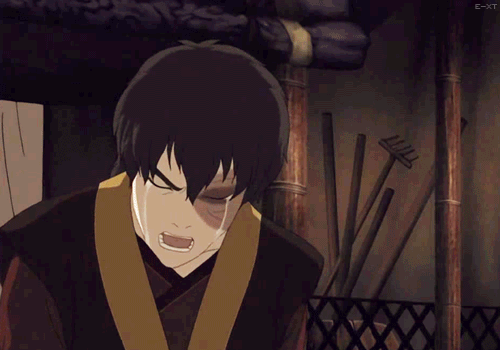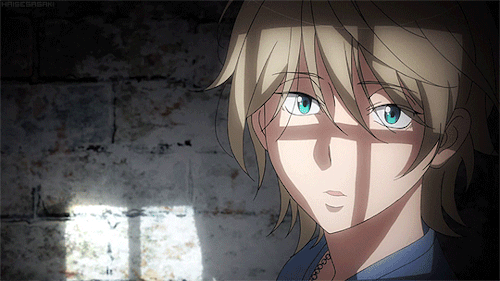Redemption and Degeneration Arcs: A Study.
Because I was awakened at five in the morning by a pouncing 65-pound dog I do not own that demanded a 2-mile walk, I got a neat idea which made me start thinking about redemption and degeneration arcs, so here’s a REALLY long post compositing my thoughts on the subject, mostly for personal use.
Redemption Arcs:
Obviously, the best redemption arc in media history is Zuko, so here’s what I learned about making good ones from him.
1. Constant Positive Influence. The roots of a redemption arc should be introduced as early as possible. In fact, the start of redemption is the introduction of a positive influence in the Redeemed’s life. Zuko had Iroh to help him make good decisions, and when Zuko didn’t have Iroh, his forward progress was halted.
2. Goodness Within. A positive influence isn’t there to plant goodness, it’s there to bring out the goodness already within a character, even if it’s hidden. We see Zuko’s goodness in the actions he does unprompted and alone, like when he rescues Aang as the Blue Spirit, or when he doesn’t rob a couple when he sees the woman is pregnant, and later saves an entire village.
3. Struggle. The change shouldn’t be overnight, but it shouldn’t be gradual either. Characters should struggle with the inner conflict of changing and have dramatic ups and downs (because that’s when major breakthroughs can happen). Zuko’s ups and downs are obvious, so another example is when the Beast, in a single moment, lashes out against Belle but saves her from wolves right after. His temper and internal goodness are struggling; it should be an epic battle, not one suffocating the other in its sleep!
4. Redemption is Earned. A struggle is good, but the consequences are even better. Actions are pretty loud, but words must have their place, too. A character should admit to being wrong and confess a desire to be better. Part of that is paying the price of previous actions, and doing the hard work of current good actions. Zuko’s bad deeds always catch up with him, and even when he becomes a member of the Gaang, the others don’t trust him right away; not until he helps Katara get closure, and Sokka save his father, and Aang learn to firebend does he gradually earn his way into their family. But remember, he’s rewarded for his good actions, too (motivation for continued goodness!).
5. Negative Traits and Problems Don’t Disappear. An antagonist doesn’t leave their personality behind when changing their goals, methods, and motivations. Zuko was a pessimist as a child (he’ll never be as good as Azula!), a pessimist as a bad guy (it just keeps blowing up in my face!), and a pessimist as a good guy (I’m never happy). He’s solemn and sulky and never becomes a bubbly optimist like Aang. And that’s because no matter how he changes, he will always have grown up with an abusive father and sister, and he will always have lost the people he loves. The struggle to achieve goodness is awesome, but maintaining it should still be a struggle.
5.1. The Traits That Lead to Downfall Are Transformed Rather Than Lost. One of Zuko’s major problems was pride: he spoke out when he shouldn’t have, he had trouble admitting when he was wrong or had failed. But over time, his pride becomes confidence. Another amazing redemption arc is found in Deep Space Nine. Garak goes from high-ranking Cardassian spy, to exile, to helping the Federation end a destructive war. He’s a minor character, so we don’t get to see the beginning of his character arc, but some negative traits of his are extreme secretiveness and lying; by the end of the show, and after his own requisite flip-flopping struggles, these were not lost but transformed into protectiveness.
6. Confrontation With Good and Bad. To solidify and end a redemption arc, the redeemed character should confront an external negative influence in order to finally put the past behind them. In Zuko’s case, his redemption is finally complete when he wins the Agni Kai against Azula. This is the moment where he faces his final demon and acknowledges his victory over his past. Azula can’t sway him again! But before this battle, another confrontation happens: Zuko humbly, and without expecting anything, asks for Iroh’s forgiveness, and receives it unconditionally. I think this is where we really forgave Zuko, too, which allowed us to celebrate his final victory with him.

Degeneration Arcs:
The absolute best degeneration arc I’ve ever seen is Slaine from Aldnoah.zero, with Michael Corleone from the Godfather as a close second. I’ll be using these guys to illustrate my points. (Side Note: I adore degeneration, if you know of any good ones, let me know.)
1. Source of Degeneration is a Virtue Taken to Extremes. No one starts out as a bad person; there has to be some kind of source for future downfall, one that can be relatable to a certain point before crossing a line into villainousness. In Aldnoah.zero, everything Slaine does is out of loyalty to the princess who saved his life. He kills to protect her, he wages war in her name. Which, you know, would be fine: except she didn’t ask him to do that. The bad choices were still entirely his, built from his too-extreme loyalty.
2. Motivation is Personal. A character needs a goal to motivate their actions - we all know that. But downfalls rarely happen because of a vague cause off in the distance. Causes are hero stuff. Villains take things personally. This is the call-to-action of failure and should connect to the extreme value mentioned before. The most common motivation for degeneration is revenge. Season 2 of Aldnoah.zero shows an epic personal fight between Slaine and the protagonist, Inaho (Side note: an amazing part of the series is that Inaho and Slaine have the same goals and motivations, to protect the princess and take revenge, and this beautiful tension arises from the fact that they go about it differently. Man, I need to rewatch this show). The same is true of Michael Corleone! He’s willing to kill two people and go into hiding because his father was shot. That’s another point: specific motivation should come from their values; Michael values family above everything, just like Slaine values the princess.
3. The Environment Encourages Their Bad Behavior. It’s really hard to have a downward character arc when surrounded by friends and family telling you to do the right thing. But both Slaine and Michael are in the middle of an all-out war. Murder and plotting are all around, are excused and even rewarded, and are valuable to the other characters.
4. Badness Comes Easily. As mentioned before, it’s a character’s values taken to extremes that contribute to the degeneration, and just like the redeemed has goodness in them, a degenerate should be somewhat suited to degeneration, in terms of personality or intelligence. Artemis Fowl is a complicated character with many different arcs, but when he does bad things, it’s because his intelligence makes scheming a simple task for him. When it comes down to it, even though it’s against Michael’s values and he wants the family business to go straight, he’s really good at being the Don because he has intelligence, patience, a bad temper, and excellent self-control. Degeneration should still be an up and down struggle, but it should come much more easily than redemption.
5. Consequences and Success. This really depends on the story you want to tell, but usually the consequences of degeneration should be pushed towards the end of the arc where they finally culminate in complete destruction. This is because constant punishment or failure will prevent future negative actions. If you’re burned, you’re not going to touch the stove again. But you can gradually raise the temperature without noticing until you’re cooked. Slaine is actually winning the war for a long time - he becomes more powerful, more respected, and more successful - until he’s defeated, loses everything, and spends the rest of his life in prison. Degeneration should ironically have positive results…until suddenly it doesn’t, and a character has lost everything, whether they admit they were wrong or not.
6. Suffering. A lack of immediate negative consequences for actions does not eliminate suffering. In fact, suffering is the momentum of degeneration. It can be a force that keeps them on the wrong path. Slaine endures torture to protect his princess, and later he kills his father figure. Michael finds out his brother betrayed him, and later his wife leaves him. The interesting thing here is that they suffer without failing at their greater goal. Another thing is the mix of forced suffering and chosen suffering. They didn’t ask to be tortured or betrayed, but Slaine pulled the trigger himself, and Michael knew his wife was unhappy.
7. Remorse. This again depends on the story, but regret (if not repentance) concludes a degeneration arc, and it is oh so juicy. They don’t have to regret what they did, but they should at least regret that it didn’t work. If a character does not realize they were wrong or does not acknowledge they have failed in some way, then their arc, at least from their perception, never degenerated at all. Just look at this last glimpse we have of Slaine and tell me the pain in his eyes is not so satisfying you can’t even.

That’s it! Bye!
I have two foil characters who go through a redemption and degeneration arc, respectively, so this will be a really good ref post! You make awesome points here :D



